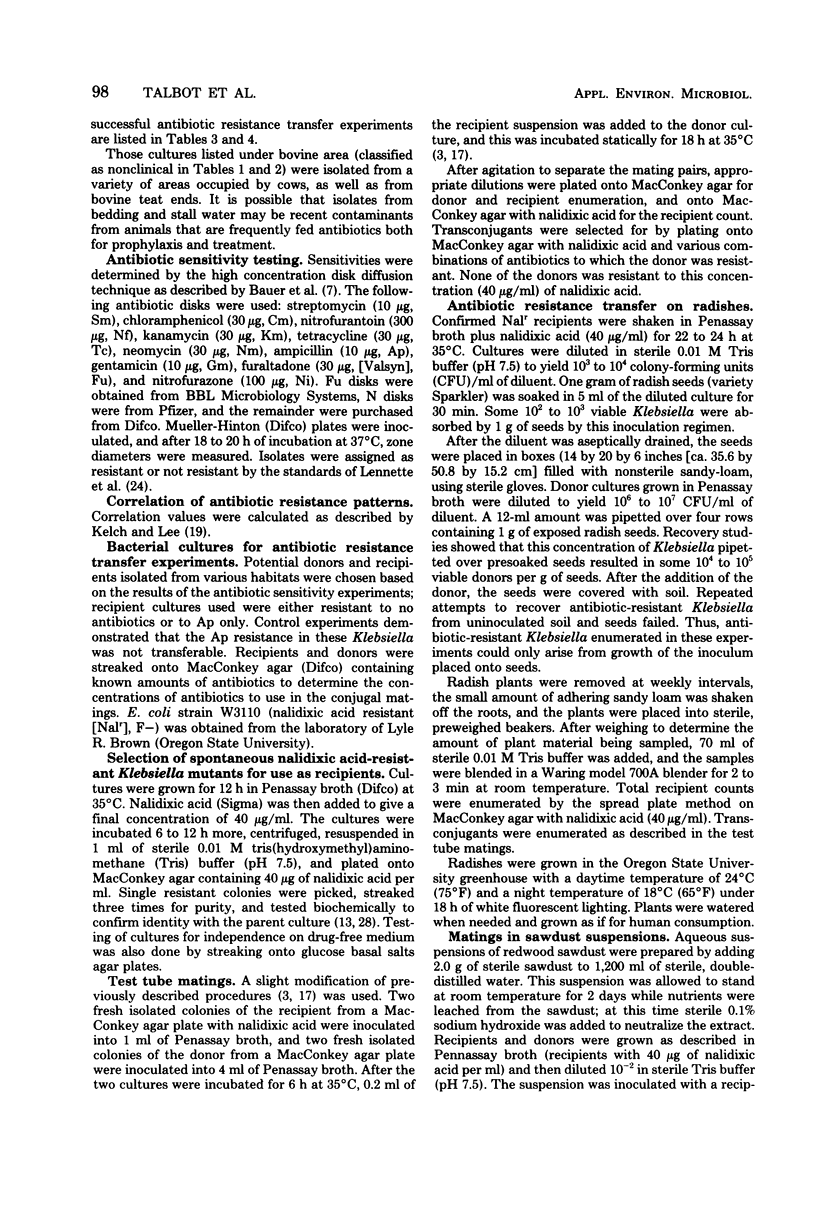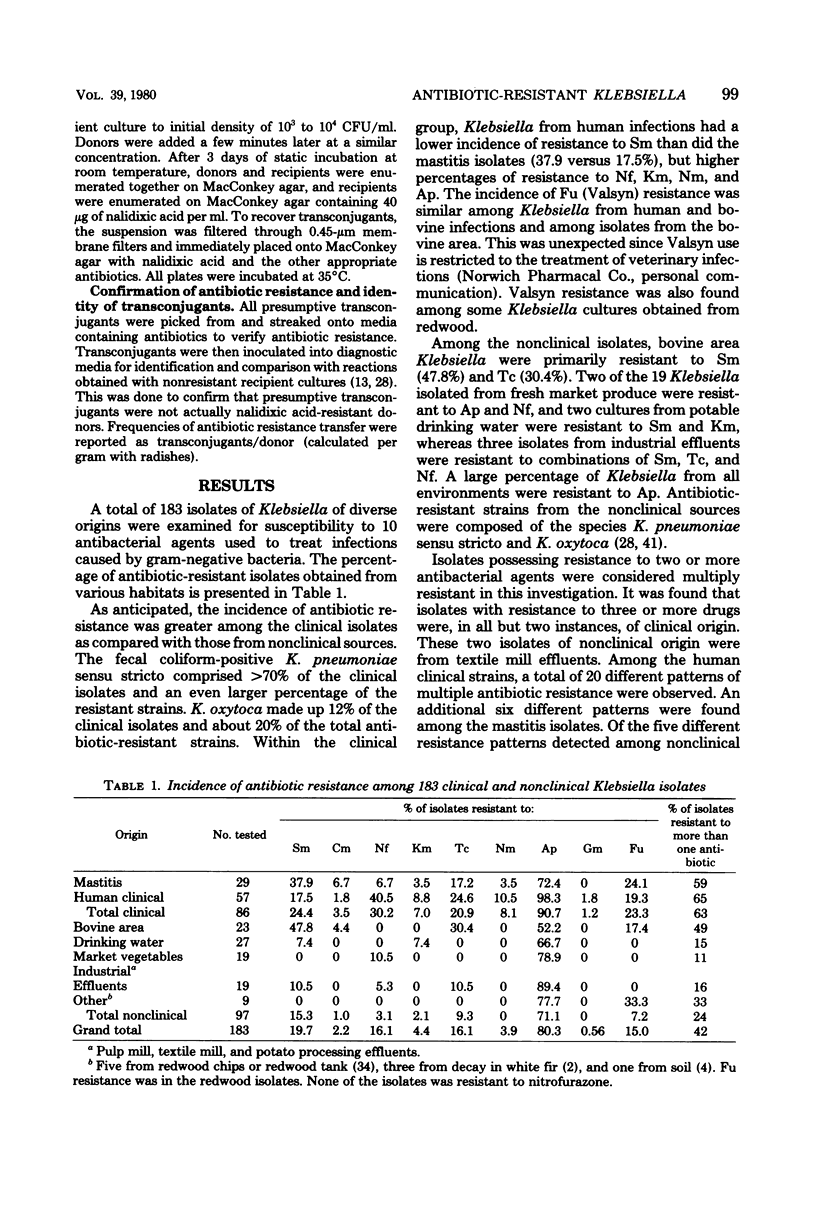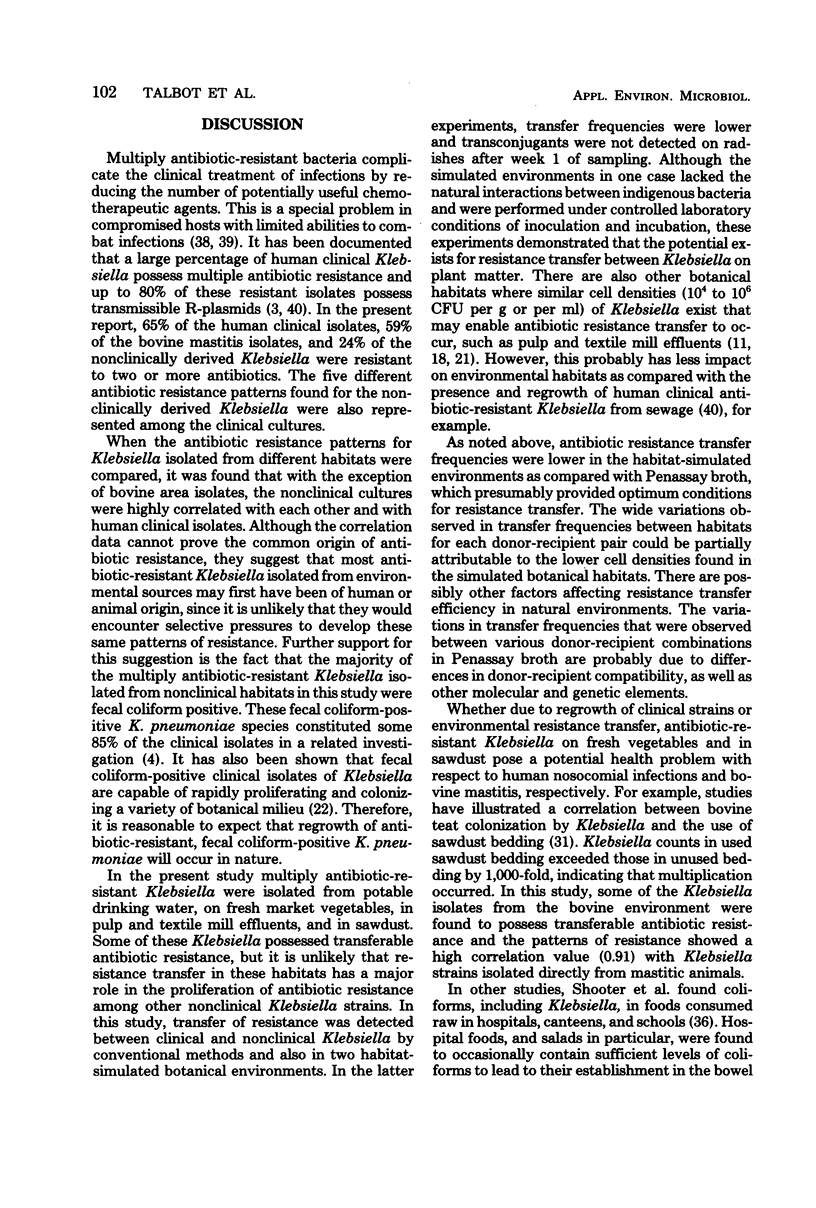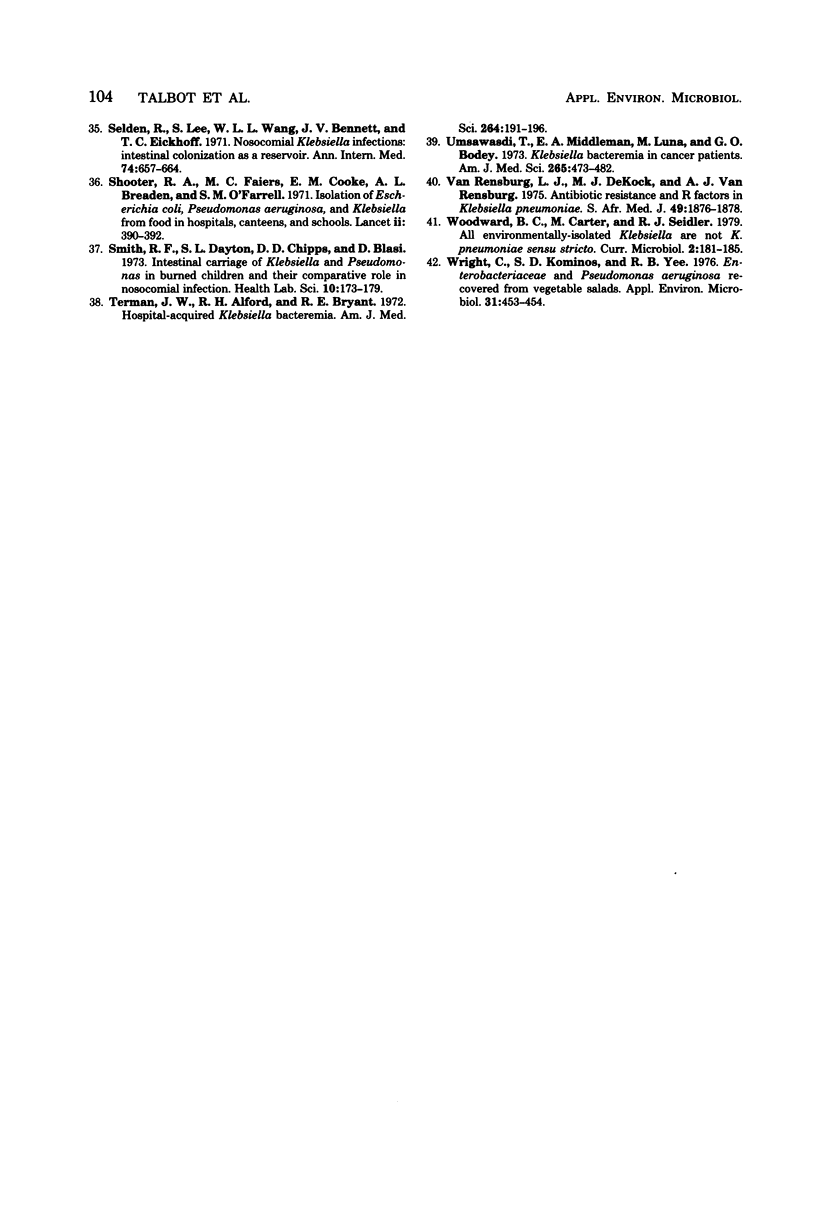Abstract
A total of 183 isolates of Klebsiella from drinking water, market vegetables, wood, sawdust, industrial effluents, and human and animal origin were examined for susceptibility to 10 antibacterial agents. Incidence of resistance to two or more antibiotics tested was: 65% of the human clinical isolates, 59% among bovine mastitis, and 24% among the nonclinical isolates. The five different multiple resistance patterns among nonclinically derived Klebsiella were also found among the human and bovine mastitis isolates. Statistical analyses revealed that patterns of resistance among Klebsiella isolates from drinking water, market vegetables, and industrial effluents were highly correlated with each other and with resistance patterns of human clinical isolates. Antibiotic resistance was transferred between Klebsiella growing in two habitat-simulated environments (growing radish plants and aqueous sawdust suspensions). Transconjugants were detected in 5 of 21 and 6 of 21 mating pairs, respectively. Average transconjugants/donor ranged from 10−3 to 10−6 in Penassay broth, from 10−6 to 10−7 on radish plants, and from 10−5 to 10−8 in sawdust suspensions. Although antibiotic resistance transfer under simulated environmental conditions can occur, regrowth of clinical strains is probably the major cause for the widespread occurrence of antibiotic-resistant Klebsiella in the nonclinical environment.
Full text
PDF







Selected References
These references are in PubMed. This may not be the complete list of references from this article.
- Adler J. L., Shulman J. A., Terry P. M., Feldman D. B., Skaliy P. Nosocomial colonization with kanamycin-resistant Klebsiella pneumoniae, types 2 and 11, in a premature nursery. J Pediatr. 1970 Sep;77(3):376–385. doi: 10.1016/s0022-3476(70)80004-x. [DOI] [PubMed] [Google Scholar]
- Bagley S. T., Seidler R. J. Comparative pathogenicity of environmental and clinical Klebsiella. Health Lab Sci. 1978 Apr;15(2):104–111. [PubMed] [Google Scholar]
- Bagley S. T., Seidler R. J. Significance of fecal coliform-positive Klebsiella. Appl Environ Microbiol. 1977 May;33(5):1141–1148. doi: 10.1128/aem.33.5.1141-1148.1977. [DOI] [PMC free article] [PubMed] [Google Scholar]
- Bagley S. T., Seidler R. J., Talbot H. W., Jr, Morrow J. E. Isolation of Klebsielleae from within living wood. Appl Environ Microbiol. 1978 Jul;36(1):178–185. doi: 10.1128/aem.36.1.178-185.1978. [DOI] [PMC free article] [PubMed] [Google Scholar]
- Bauer A. W., Kirby W. M., Sherris J. C., Turck M. Antibiotic susceptibility testing by a standardized single disk method. Am J Clin Pathol. 1966 Apr;45(4):493–496. [PubMed] [Google Scholar]
- Braman S. K., Eberhart R. J., Asbury M. A., Hermann G. J. Capsular types of Klebsiella pneumoniae associated with bovine mastitis. J Am Vet Med Assoc. 1973 Jan 15;162(2):109–111. [PubMed] [Google Scholar]
- Brown C., Seidler R. J. Potential pathogens in the environment: Klebsiella pneumoniae, a taxonomic and ecological enigma. Appl Microbiol. 1973 Jun;25(6):900–904. doi: 10.1128/am.25.6.900-904.1973. [DOI] [PMC free article] [PubMed] [Google Scholar]
- Cichon M. J., Craig C. P., Sargent J., Brauner L. Nosocomial Klebsiella infections in an intensive care nursery. South Med J. 1977 Jan;70(1):33–35. doi: 10.1097/00007611-197701000-00016. [DOI] [PubMed] [Google Scholar]
- Dufour A. P., Cabelli V. J. Charateristics of Klebsiella from textile finishing plant effluents. J Water Pollut Control Fed. 1976 May;48(5):872–879. [PubMed] [Google Scholar]
- Duncan D. W., Razzell W. E. Klebsiella biotypes among coliforms isolated from forest environments and farm produce. Appl Microbiol. 1972 Dec;24(6):933–938. doi: 10.1128/am.24.6.933-938.1972. [DOI] [PMC free article] [PubMed] [Google Scholar]
- Fox J. G., Rohovsky M. W. Meningitis caused by Klebsiella spp in two rhesus monkeys. J Am Vet Med Assoc. 1975 Oct 1;167(7):634–636. [PubMed] [Google Scholar]
- Gardner P., Smith D. H. Studies on the epidemiology of resistance (R) factors. I. Analysis of Klebsiella isolates in a general hospital. II. A prospective study of R factor transfer in the host. Ann Intern Med. 1969 Jul;71(1):1–9. doi: 10.7326/0003-4819-71-1-1. [DOI] [PubMed] [Google Scholar]
- Hable K. A., Matsen J. M., Wheeler D. J., Hunt C. E., Quie P. G. Klebsiella type 33 septicemia in an infant intensive care unit. J Pediatr. 1972 Jun;80(6):920–924. doi: 10.1016/s0022-3476(72)80002-7. [DOI] [PubMed] [Google Scholar]
- Hinshaw V., Punch J., Allison M. J., Dalton H. P. Frequency of R factor-mediated multiple drug resistance in Klebsiella and Aerobacter. Appl Microbiol. 1969 Feb;17(2):214–218. doi: 10.1128/am.17.2.214-218.1969. [DOI] [PMC free article] [PubMed] [Google Scholar]
- Huntley B. E., Jones A. C., Cabelli V. J. Klebsiella densities in waters receiving wood pulp effluents. J Water Pollut Control Fed. 1976 Jul;48(7):1766–1771. [PubMed] [Google Scholar]
- Kelch W. J., Lee J. S. Antibiotic resistance patterns of gram-negative bacteria isolated from environmental sources. Appl Environ Microbiol. 1978 Sep;36(3):450–456. doi: 10.1128/aem.36.3.450-456.1978. [DOI] [PMC free article] [PubMed] [Google Scholar]
- Kinkler R. J., Jr, Wagner J. E., Doyle R. E., Owens D. R. Bacterial mastitis in guinea pigs. Lab Anim Sci. 1976 Apr;26(2 Pt 50):214–217. [PubMed] [Google Scholar]
- Knittel M. D., Seidler R. J., Eby C., Cabe L. M. Colonization of the botanical environment by Klebsiella isolates of pathogenic origin. Appl Environ Microbiol. 1977 Nov;34(5):557–563. doi: 10.1128/aem.34.5.557-563.1977. [DOI] [PMC free article] [PubMed] [Google Scholar]
- Koonkhamlert C., Sawyer W. D. Drug-resistant Escherichia coli and Klebsiella-Enterobacter in healthy adults in Thailand and the effect of antibiotic administration. Antimicrob Agents Chemother. 1973 Aug;4(2):198–200. doi: 10.1128/aac.4.2.198. [DOI] [PMC free article] [PubMed] [Google Scholar]
- Matsen J. M., Spindler J. A., Blosser R. O. Characterization of Klebsiella isolates from natural receiving waters and comparison with human isolates. Appl Microbiol. 1974 Oct;28(4):672–678. doi: 10.1128/am.28.4.672-678.1974. [DOI] [PMC free article] [PubMed] [Google Scholar]
- Merkt H., Klug E., Bohm K. H., Weiss R. Recent observations concerning Klebsiella infections in stallions. J Reprod Fertil Suppl. 1975 Oct;(23):143–145. [PubMed] [Google Scholar]
- Montgomerie J. Z., Doak P. B., Taylor D. E., North J. D., Martin W. J. Klebsiella in faecal flora of renal-transplant patients. Lancet. 1970 Oct 17;2(7677):787–792. doi: 10.1016/s0140-6736(70)91458-3. [DOI] [PubMed] [Google Scholar]
- Noriega E. R., Leibowitz R. E., Richmond A. S., Rubinstein E., Schaefler S., Simberkoff M. S., Rahal J. J., Jr Nosocomial infection caused by gentamicin-resistant, streptomycin-sensitive Klebsiella. J Infect Dis. 1975 May;131 (Suppl):S45–S50. doi: 10.1093/infdis/131.supplement.s45. [DOI] [PubMed] [Google Scholar]
- Nunez W. J., Colmer A. R. Differentiation of Aerobacter-Klebsiella isolated from sugarcane. Appl Microbiol. 1968 Dec;16(12):1875–1878. doi: 10.1128/am.16.12.1875-1878.1968. [DOI] [PMC free article] [PubMed] [Google Scholar]
- Seidler R. J., Knittel M. D., Brown C. Potential pathogens in the environment: cultural reactions and nucleic acid studies on Klebsiella pneumoniae from clinical and environmental sources. Appl Microbiol. 1975 Jun;29(6):819–825. doi: 10.1128/am.29.6.819-825.1975. [DOI] [PMC free article] [PubMed] [Google Scholar]
- Seidler R. J., Morrow J. E., Bagley S. T. Klebsielleae in drinking water emanating from redwood tanks. Appl Environ Microbiol. 1977 Apr;33(4):893–900. doi: 10.1128/aem.33.4.893-900.1977. [DOI] [PMC free article] [PubMed] [Google Scholar]
- Selden R., Lee S., Wang W. L., Bennett J. V., Eickhoff T. C. Nosocomial klebsiella infections: intestinal colonization as a reservoir. Ann Intern Med. 1971 May;74(5):657–664. doi: 10.7326/0003-4819-74-5-657. [DOI] [PubMed] [Google Scholar]
- Shooter R. A., Cooke E. M., Faiers M. C., Breaden A. L., O'Farrell S. M. Isolation of Escherichia coli, Pseudomonas aeruginosa, and Klebsiella from food in hospitals, canteens, and schools. Lancet. 1971 Aug 21;2(7721):390–392. doi: 10.1016/s0140-6736(71)90111-5. [DOI] [PubMed] [Google Scholar]
- Smith R. F., Dayton S. L., Chipps D. D., Blasi D. Intestinal carriage of Klebsiella and pseudomonas in burned children and their comparative role in nosocomial infection. Health Lab Sci. 1973 Jul;10(3):173–179. [PubMed] [Google Scholar]
- Terman J. W., Alford R. H., Bryant R. E. Hospital-acquired Klebsiella bacteremia. Am J Med Sci. 1972 Sep;264(3):191–196. [PubMed] [Google Scholar]
- Umsawasdi T., Middleman E. A., Luna M., Bodey G. P. Klebsiella bacteremia in cancer patients. Am J Med Sci. 1973 Jun;265(6):473–482. doi: 10.1097/00000441-197306000-00006. [DOI] [PubMed] [Google Scholar]
- Wright C., Kominos S. D., Yee R. B. Enterobacteriaceae and Pseudomonas aeruginosa recovered from vegetable salads. Appl Environ Microbiol. 1976 Mar;31(3):453–454. doi: 10.1128/aem.31.3.453-454.1976. [DOI] [PMC free article] [PubMed] [Google Scholar]
- van Rensburg L. J., de Kock M. J., van Rensburg A. J. Antibiotic resistnace and R factors in Klebsiella pneumoniae. S Afr Med J. 1975 Oct 25;49(45):1876–1878. [PubMed] [Google Scholar]


